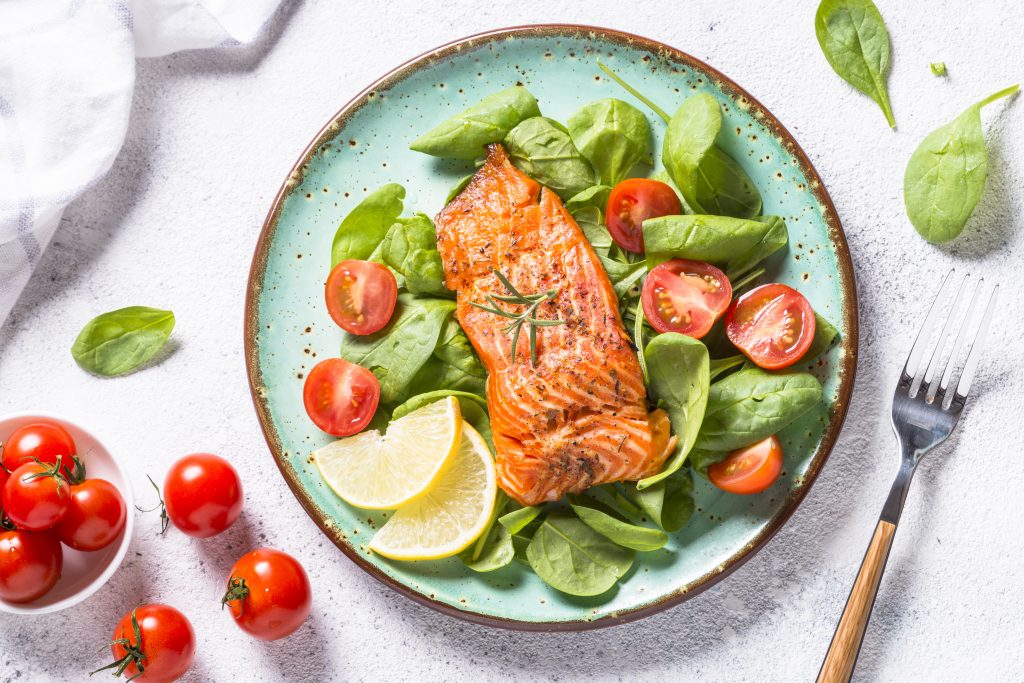New Year Ketogenic Reset
January 4, 2018 By Sarah WhiteNo Comments

My new favourite way to reset after the holidays (or any period of excess food and drink) is to follow a strict ketogenic diet for 20 days. This is an excellent and delicious way to reset my blood sugar levels (and lose a few post-holiday pounds) after a few weeks of indulging. Today’s post will teach you how to do your own keto-style diet in order to reset your insulin levels & metabolism for a healthy transition into this new year.
What is the Ketogenic diet:
The ketogenic diet is a high-fat, low-carbohydrate diet that helps to control weight. Ketogenic comes from the word ketones (keto = ketone / genic = producing). Ketones are formed when the body uses fat for its main source of energy. Your body preferentially uses carbohydrates for its fuel, but when you follow a very low carbohydrate diet (like the ketogenic diet) fats become the primary fuel source instead. To attain ketosis, you need to eat a diet that is very low in carbohydrate and high in healthy fats. This means that your diet is based mostly on plant and animal fat, protein, and green vegetables. Through this 20-day reset you should aim to consume less than 50 grams carbohydrate per day.
Why do a Keto-Reset:
In a recent study, subjects who ate a ketogenic diet for 20 days, followed by a low carb diet for 20 days experienced and sustained significant weight loss and blood sugar regulation. In order to understand why this happens you need to know how your body works to maintain normal blood sugar levels. There are two hormones that control blood sugar, one is insulin and the other is the opposing hormone called glucagon. They antagonize one another meaning that they can’t coexist in your blood stream. Insulin is your fat-storing hormone which is secreted in large amounts when we eat carbohydrates, while glucagon is often referred to as a ‘fat-burning’ hormone and is active during periods of fasting or low-carbohydrate dieting. If you’re eating carbohydrates throughout the day your insulin levels will remain elevated and you will never tap into the power of the fat-burning glucagon hormone. By taking a break from the insulin-sugar roller coaster ride you can effectively retrain your body to release less insulin thereby upregulating glucagon production.
How-to Keto:
- A ketogenic diet plan requires tracking the carb amounts in the foods eaten and keeping carbohydrate intake under 50 grams per day (these are net carbs which means you can subtract 1 gram of carb per gram of fiber that you eat).
- The nutrient intake on a ketogenic diet typically works out to about 70-75% of calories from fat, 20-25% from protein, and 5-10% from carbohydrate on a daily basis.
- I typically recommend that my patients use a macronutrient tracker like My Fitness Pal to help them get used to measuring the fat, carbohydrates and protein in their meals.
Here is a list of some suitable foods for someone following a ketogenic diet:
- Fresh preferably organic meat (such as beef, pork, veal, lamb): avoid processed meats like hotdogs and deli meats.
- Poultry preferably organic (chicken, turkey, etc.): it’s better to leave the skin on your poultry to increase the fat content.
- Fish and shellfish: if you buy canned fish make sure it hasn’t been preserved with added sugar.
- Eggs: Many keto recipes call for eggs since they’re a perfect ratio of fat to carbs.
- Cheese: If well tolerated, most types of cheese are suitable for a ketogenic diet.
- Vegetables: Vegetables will be the source of most of the carbs you eat, but you still need to choose the lowest carb vegetables possible in order to stay under 50g carbohydrates. Green leafy vegetables are your best bet, such as: spinach, lettuce, kale, cabbage. You can also eat broccoli and cauliflower, celery, cucumber, asparagus, bean sprouts, radishes and more, but try to limit intake of sugary vegetables like peppers and tomatoes, and avoid starchy vegetables like potatoes.
- Nuts & oils, butter (Ghee), organic cream and homemade mayonnaise.
- Coconut Oil: The medium chain triglycerides (MCT) found in coconut oil are an excellent option while on the ketogenic diet since they increase natural formation of ketones due to the high (66%) MCT content.
Looking to connect with a Naturopath in Oakville to develop a personalized keto reset protocol? Book your in-person appointment here or visit my website for more information.
If you’d like to work together and you’re not a resident of Ontario*, or if you do live in Ontario and you’d prefer an online consultation you can book online with Dr. Sarah here.
*Note: online services provided by Dr. Sarah to those of you living outside of Ontario are delivered as a Certified Functional Medicine practitioner consult and not as an Naturopathic doctor appointment & as such they will not be eligible for reimbursement through private insurance.
References:
- https://www.ncbi.nlm.nih.gov/pmc/articles/PMC3875914/
- https://www.ncbi.nlm.nih.gov/pmc/articles/PMC3945587/
- https://www.ncbi.nlm.nih.gov/pmc/articles/PMC2367001/
This information is not intended as a substitute for the advice provided by your Naturopathic doctor or primary care physician. Do not use the information in this document for diagnosing or treating a health problem or disease. Always speak with your Naturopathic doctor before taking any medication or nutritional or herbal or using any treatment for a health problem. If you have or suspect that you have a medical problem, contact your health care provider promptly. Do not disregard professional medical advice or delay in seeking professional advice because of something you have read online.
COMMENTS
Leave a Reply
This site uses Akismet to reduce spam. Learn how your comment data is processed.
Mauren Meneses says
MAY 13, 2021 AT 8:15 AM
Hormonal issues and nutritional help
Reply